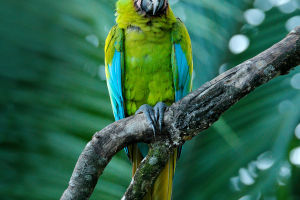Peacock
The peacock is the largest bird in the order Chickadee. It is more than 2 meters long, with a tail screen of about 1.5 meters. The top of the head is bright green and the crown is blue-green and pointed. The tail feathers are particularly long, forming a tail screen that is bright and beautiful.
The true tail feathers are very short and dark brown. Females have no tail screen and have dark brown and mottled plumage.
The peacock inhabits open areas of the forest. The blue peacock is found in India and Sri Lanka; the green peacock is found in Southeast Asia. The albino variety is called the white peacock with a snowy white body.
The Congo peacock was only discovered in 1936 and is 70 cm long, with black males and white tufted feathers on the top of the head and green and brown females. They are found in the tropical regions of Africa.
They mainly inhabit tropical and subtropical evergreen broad-leaved forests and mixed forests below 2,000 meters above sea level and especially like to live in open grasslands, river banks, or jungles along the land, as well as grasslands between forests and open grasslands in forests or open areas with bushes and bamboo thickets, from plains to forests and thickets in alpine areas. They prefer to live near streams.
Peacocks are resident birds. Early in the morning and towards the evening, feeding activities are more frequent. They are often found in flocks and sometimes singly and in pairs.
Peacocks are not good at flying. They run as fast as they can and generally run away from enemies in large strides, fleeing through dense forests. They seldom take off, but they fly fast when gliding downward.
Daytime activities, especially in the morning and afternoon activities more, noon more up in the trees or in the shade of the forest to rest, the night perched in the trees. They are alert and timid.
The white peacock is a variant of the wild blue peacock under artificial breeding. It is rare in number and is an extremely valuable ornamental bird. But after artificial domestication, it has reached the state of a self-sustaining population.
The whole body is white, with unadulterated feathers and light red eyes. Since the white peacock is a variation of the Indian peacock, zoologists generally believe that the ancestry of the white peacock is in India and Sri Lanka. Nowadays, white peacocks are also found in various zoos.
Similar to other peacocks, white peacocks prefer to live in hilly forests, dry semi-deserted grasslands, shrubs, and deciduous forest areas, especially near water. Early in the morning and evening, it follows its flock to the fields to feed, preferring to nest on the ground but roosting in trees, feeding mainly on seeds, insects, fruits, and small reptiles.
The white peacock has underdeveloped wings and is not good at flying, but has strong feet and is good at sprinting and running, mostly in large strides when fleeing, foraging generally in the early morning and dusk, coming to the stream in the early morning to drink water, while cleaning feathers, and then go together to the woods to feed, and rest in the shade at noon in the heat, and again at dusk to feed. In the evening, they fly up to the branches of the trees to rest.
When it comes to peacocks, the most impressive thing is the behavior of peacocks opening their screens. There are three reasons why peacocks open their screens.
1. Courtship. In spring, when peacocks lay eggs and reproduce, male peacocks will open their screens to show off their beauty to female peacocks, thus attracting them.
2. To protect themselves. On the peacock screen, there are many nearly round "eye-like spots", which can play the role of camouflage, demonstration, and defense when encountering enemies.
3. Frightened. In zoos we often see peacocks opening their screens. Zoologists believe that tourists laughing loudly and wearing colorful clothing will stimulate the peacock so that the peacock is frightened and open the screen. Peacocks are at their peak in March and April, which is their breeding season, so if you want to see them open, this is the right time to go.


